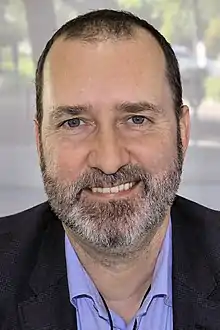Kevin Ashton | |
|---|---|
 Ashton at the 2015 Texas Book Festival. | |
| Born | 1968 Birmingham, England |
| Nationality | British |
| Children |
|
Kevin Ashton (born 1968) is a British technology pioneer who cofounded the Auto-ID Center at the Massachusetts Institute of Technology (MIT), which created a global standard system for RFID and other sensors.[1] He is known for coining the term "the Internet of Things"[2] to describe a system where the Internet is connected to the physical world via ubiquitous sensors.[3][4]
Biography
Ashton was born in Birmingham, UK. He read Scandinavian Studies at University College London from 1990 to 1994. He was working as an assistant brand manager at Procter & Gamble (P&G) in 1997 when he became interested in using RFID to help manage P&G's supply chain.[1] This work led him to MIT, where he helped start an RFID research consortium called the Auto-ID Center with professors Sanjay Sarma and Sunny Siu and researcher David Brock. The center opened in 1999 as an industry-sponsored research project with the goal of creating a global open standard system to put RFID everywhere. Ashton was the Center's Executive Director. Siu, then Sarma, acted as Research Director, later Chairman of Research. Under Ashton and Sarma's leadership, the number of sponsors grew to 103, and additional labs were funded at other major universities around the world. Once the system was developed, MIT licensed it to not-for-profit standards body GS1 and the project reached a successful conclusion. The labs were renamed Auto-ID Labs and continue their research.
Ashton became a high-tech entrepreneur with start-ups ThingMagic,[5] cleantech company EnerNOC (NASDAQ:ENOC) and Zensi, an energy-sensing company he founded with Shwetak Patel among others. Zensi was acquired by Belkin International in April 2010.[6] Ashton then developed and launched the Belkin Wemo (originally stylized as WeMo) home automation system. He writes for RFID Journal, Medium and Quartz, and published a book, How to Fly a Horse with Random House in 2015. In January 2016, How to Fly a Horse won "Best Business Book" from 1-800-CEO-READ.
For an April 2013 Quartz article Ashton created Santiago Swallow, a fictional Mexican social media guru who specializes in the "imagined self", the fictional expert was furnished with 90,000 paid-for Twitter followers and a Wikipedia biography. The creation of Swallow is an attempt to show that credibility is unrelated to the quantity of Twitter followers.[7]
Scientific publications
Kevin Ashton's scientific publications can be found in leading science and media journals:
References
- 1 2 Wired Magazine, July 2004
- ↑ W. E. Zhang (2020). "The 10 Research Topics in the Internet of Things". 2020 IEEE 6th International Conference on Collaboration and Internet Computing (CIC). pp. 34–43. arXiv:2012.01594. doi:10.1109/CIC50333.2020.00015. ISBN 978-1-7281-4146-6. S2CID 227253677.
- ↑ Goetz, Thomas (19 June 2011). "Harnessing the Power of Feedback Loops". Wired.
- ↑ Kevin Ashton, "That 'Internet of Things' Thing", RFID Journal, 22 June 2009.
- ↑ RFID Journal 2004
- ↑ "GigaOm, April 2010". Archived from the original on 6 November 2012. Retrieved 23 December 2011.
- ↑ McGuiness, Ross (20 April 2013). "Meet Santiago Swallow… the biggest social media star you've never heard of". Metro. Retrieved 20 April 2013.
- ↑ "Kevin Ashton May Change the World - The Auto-ID Center Executive Director's vision of an open system for tracking goods with low-cost RFID tags will have an effect on nearly everyone someday". rfidjournal.com. Emerald X, LLC. 15 April 2002. Retrieved 10 June 2021.
- ↑ "Kevin Ashton Called a thing the Internet of Things. Wrote How to Fly a Horse—The Secret History of Creation, Invention, and Discovery". medium.com. Medium. Retrieved 10 June 2021.
- ↑ "Kevin Ashton led pioneering work on RFID (radio frequency identification) networks, for which he coined the term "the Internet of Things," and co-founded the Auto-ID Center at MIT. Kevin pioneered the sensor-based technology that powers smart energy grids and advanced metering — the systems at the heart of clean tech today". qz.com. Quartz Media. Retrieved 10 June 2020.
External links
- What's with this "internet of things"?, How Stuff Works
- DC Velocity Thought Leader Profile
- Wired magazine feature on Kevin Ashton & RFID
- Press Release About Belkin Acquiring Zensi
- Earth2Tech On The History Of Zensi Archived 25 April 2010 at the Wayback Machine
- How to Fly a Horse: The Secret History of Creation, Invention, and Discovery